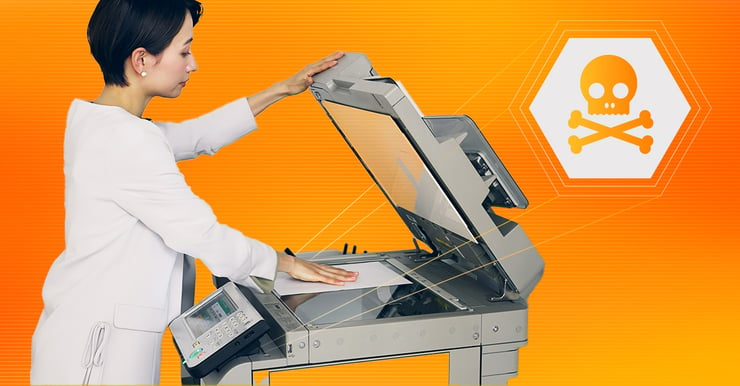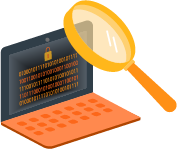Printers may appear to be low-maintenance and relatively safe devices. However, printers are a common attack vector used by cybercriminals to gain access to an enterprise network. Multifunctional printers (MFPs) and copiers contain security risks and vulnerabilities that need to be prioritized and addressed.
Failure to do so could result in significant data breaches and security incidents. The global average cost of a data breach in 2023 was $4.45 million, which is all the proof enterprises need to make printer security a part of every security strategy.
Why Do Printers Pose Security Threats and Vulnerabilities?
Every connected device is susceptible to cybersecurity vulnerabilities and printers are no exception. While their primary duties involve basic print jobs, modern printers are also gateways to an enterprise’s most sensitive information. Hackers can easily take advantage of unsecured printers to spread ransomware, cause data breaches, and move laterally to challenge other aspects of an organization’s network security.

Data breaches and security incidents can also have compliance implications because all businesses have to abide by regulatory frameworks like the Health Insurance Portability and Accountability Act (HIPAA).
Businesses avoid security and compliance violations by addressing endpoint vulnerabilities. Unfortunately, year after year, office printers are neglected and the necessary security measures aren’t implemented. The short-term repercussions of data breaches can be dangerous. However, cybercriminals and their malware can often lurk within company networks, undetected. This opens up the possibility of numerous long-term challenges, some of which could be catastrophic for organizations.
According to Quocirca’s Global Print Security Landscape Report 2023, 61% of IT decision-makers suffered data losses due to unsecured printers, 39% struggled to keep up with printer security, and only 19% believe that their printer security posture can prevent data breaches. Furthermore, only 54% claimed to have completed a printer security assessment and 62% have not implemented a zero trust security model. These statistics highlight why it’s important to know about printer security risks and how to mitigate them.
Top Printer Security Risks
- Printer as initial attack vector
- WiFi related challenges
- Hacked print jobs
- Physical access to sensitive documents
- Printer misconfigurations
- Cloud printing complexities
- Data theft from decommissioned printers
- Printer malware
- Exposed printer hardware
- Unpatched firmware
- Lack of printer security strategy
Printer as Initial Attack Vector
The repercussions of hacking multifunction devices like network printers and copiers can be far-reaching. The compromise of a printer may be the first step of a much larger security breach. Hackers may use printers as a gateway to move laterally within an enterprise’s IT environment, introduce malicious code, spearhead DDoS attacks, and exfiltrate sensitive data.
WiFi-Related Challenges
Many office printers connect to wireless networks, which introduces an array of security vulnerabilities. Threat actors can potentially manipulate printers into connecting to fraudulent and dangerous networks. Hackers can use wireless printing as a vector to spread malware and even print false and harmful documents.
Hacked Print Jobs
Both internal and external threat actors can cause harm by interfering with print jobs. A print job is a list of documents that are ready for printing. Attackers can add, remove, and edit content from print jobs, which can kickstart a chain reaction of complexities. Attackers can also manipulate and alter print logs, which makes audit trails and security forensics a major challenge.
Physical Access to Sensitive Documents
Unless a printer is configured in a manner that demands access control-defined authentication, anyone in the vicinity can access and print private, sensitive, and high-value documents. This can be a major challenge if left unaddressed because it can allow all personnel to access, compromise, or expose sensitive information, private data, and intellectual property.
Printer Misconfigurations
Printer configurations establish various details of print services, including creating print queues, modifying device preferences and settings, and routing print jobs. Printer configurations can be altered by either negligent printer management and practices or malicious activity by cybercriminals. Misconfigured printers can result in re-routed and exposed documents.
Cloud Printing Complexities
There are numerous security vulnerabilities associated with cloud printing. Cloud printing can include private, public, and hybrid clouds. However, the biggest security concerns are related to public clouds because sensitive data is exposed to public internet channels. Cloud printing opens up organizations to the ominous threats of man-in-the-middle (MITM) attacks, where cybercriminals position themselves at the center of data exchange between a network device like a printer to a cloud infrastructure.
Data Theft From Decommissioned Printers
All network endpoints, including multifunction printers, need to go through a comprehensive security lifecycle. This lifecycle begins with commissioning and configuring a printer and ends up deleting all data before decommissioning and discarding it. Cybercriminals can steal high-value information from printers that have been decommissioned without data erasure.
Printer Malware
Printers, like any other IoT device, can be infected with malware. Hackers can use malware to either manipulate print jobs or gain access to an enterprise network and cause large-scale havoc. Common signs of a malware-infected multifunction printer include lagging performance, printing wrong documents, unresponsiveness to commands, and inability to be patched or updated. The Mirai Botnet is an example of dangerous malware that can proliferate to cause lasting damage.
Exposed Printer Hardware
In an era of connected devices, cloud infrastructures, and distributed networks, it can be easy to overlook the security challenges associated with hardware. Print devices contain hard drives that document copies of print jobs. A stolen, compromised, or poorly discarded printer hard drive can result in the theft of sensitive data.
Unpatched Firmware
Firmware that hasn’t been patched or updated is likely to result in performance inefficiencies and cybersecurity vulnerabilities. Printers with unpatched firmware are easier targets for cybercriminals to infiltrate enterprise networks and exfiltrate data assets.
Lack of a Printer Security Strategy
Printer security issues often blindside businesses because they lack the necessary defensive strategies, detection mechanisms, and incident response playbooks to address challenges. This is because printer security remains low on IT teams' and senior executives' cybersecurity priority lists. Quocirca revealed that only 18% of CIOs and 30% of CISOs considered printer security a critical risk. This organization-wide neglect of printer security is why only 27% of surveyed companies were qualified by Quocirca as Printer Security Leaders.
Best Practices to Mitigate Printer Security Risks
- Update printers regularly
- Proactive password management
- Use multifactor authentication
- Eliminate printing logs
- Responsibly decommission printers
- Only enable critical services
- Encrypt print job data
- Enable firewalls
- Schedule security workshops
- Enforce print governance policies
- Develop a printer security strategy
The aforementioned security risks can be mitigated by meticulously following a series of best practices. The following are the top 11 best practices that enterprises should prioritize to protect their printers.
Update Printers Regularly
Printers must be patched and updated as often as possible to ensure that they can withstand the ever-evolving techniques and tactics of cybercriminals. Both the hardware (firmware) and software (operating systems) sides of printers need to be updated.
Proactive Password Management
Enterprises should never use the same passwords for printers for extended periods. Stale passwords are a prime cause of data breaches. Passwords and PINs must be updated regularly. Enterprises should also use password generators to create complex passwords and centralized and secure repositories to store passwords and keys.
Use Multifactor Authentication (MFA)
MFA is an integral part of robust security models like zero trust. It enables an environment where users have to continuously verify their legitimacy using a varied set of authentication criteria to access print devices.
Eliminate Printing Logs
Deleting printing logs in office printers can reduce the likelihood of data breaches. Printers that don’t include print job histories are less alluring targets for cybercriminals, who may decide to give up on breaching printers and look at other attack vectors.
Responsibly Decommission Printers
Old printers that are nearing end of life should be decommissioned with security in mind. Decommissioning these printers safely should be a priority, not a formality. All printers should be cleared of data before being disposed of.
Only Enable Critical Services
Printers have numerous capabilities and protocols, including File Transfer Protocol (FTP), Hypertext Transfer Protocol (HTTP), and Telnet. These are typically automatically activated upon installation. Businesses should disable and deactivate any services that aren’t critical because they might have vulnerabilities.
Encrypt Print Job Data
Encrypting print jobs will obscure their exact details should they fall into the hands of a cybercriminal. Even in the worst-case scenario, a cybercriminal may know that a print job occurred but they wouldn’t know any further details.
Enable Firewalls
Enterprises simply need to ensure that their firewalls are enabled and activated at all times. This can provide an added layer of printer security. Pre-installed firewalls are reasonable defenses but enterprises can also boost their fortification by commissioning advanced firewalls.
Schedule Security Workshops
Businesses need to schedule seminars and workshops to establish the importance of cybersecurity, including printer security. These workshops need to be more than a formality so companies should look at integrating gamification and multimedia elements to engage their employees.
Enforce Print Governance Policies
Print governance policies are controls that determine who can access print services, what they need to do to gain access, and the limit of their access privileges. These policies should be based on zero trust principles like least privilege and continuous verification. Governance policies should focus more on enabling legitimate access than blocking employees from print services. Enforcing holistic print governance policies can significantly boost the organization's security posture and improve printing hygiene.
Develop a Printer Security Strategy
None of the above points can make an impact if performed in isolation. Like any other security initiative, printer security must be bound by a holistic strategy that combines tools, technologies, tactics, and practices. CISOs and CIOs need to work together to develop robust printer security strategies and ensure that it seamlessly integrates with the organization's overall security strategy.
Conclusion
Today, printers are more than just traditional print devices. They are connected devices, which means they are susceptible to the same security threats and vulnerabilities that any other enterprise endpoint is. The failure to protect them can result in data breaches and compliance fines that can cost companies millions of dollars.
Enterprises need to stay alert to printer security risks like the ones listed above and deftly mitigate them with best practices and robust technology. Cybersecurity is incomplete without robust printer security.
RSS
Categories: Security, Internet of Things, Document Imaging, IoT, Cyber Security, Network Security, Printing Solutions, Proactive Network Security, Security Breach, IT Security, Copier, Network, Imaging











